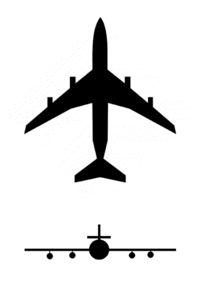- Dutch roll
-
Dutch roll is a type of aircraft motion, consisting of an out-of-phase combination of "tail-wagging" and rocking from side to side. This yaw-roll coupling is one of the basic flight dynamic modes (others include phugoid, short period, and spiral divergence). This motion is normally well damped in most light aircraft, though some aircraft with well-damped Dutch roll modes can experience a degradation in damping, as airspeed decreases and altitude increases. Dutch roll stability can be artificially increased by the installation of a yaw damper. Wings placed well above the center of mass, sweepback (swept wings) and dihedral wings tend to increase the roll restoring force, and therefore increase the Dutch roll tendencies; this is why high-winged aircraft often are slightly anhedral, and transport-category swept-wing aircraft are equipped with yaw dampers.
In aircraft design, Dutch roll results from relatively weaker positive directional stability as opposed to positive lateral stability. When an aircraft rolls around the longitudinal axis, a sideslip is introduced into the relative wind in the direction of the rolling motion. Strong lateral stability begins to restore the aircraft to level flight. At the same time, somewhat weaker directional stability attempts to correct the sideslip by aligning the aircraft with the perceived relative wind. Since directional stability is weaker than lateral stability for the particular aircraft, the restoring yaw motion lags significantly behind the restoring roll motion. As such, the aircraft passes through level flight as the yawing motion is continuing in the direction of the original roll. At that point, the sideslip is introduced in the opposite direction and the process is reversed.
The Dutch roll mode can be excited by any use of aileron or rudder, but for flight test purposes it is usually excited with a rudder singlet (short, sharp motions of the rudder to a specified angle, and then back to the centered position) or doublet (a pair of such motions in opposite directions). Some larger aircraft are better excited with aileron inputs. Periods can range from a few seconds for light aircraft to a minute or more for airliners.[citation needed]
Dutch roll is also the name (considered by professionals to be a misnomer) given to a coordination maneuver generally taught to student pilots to help them improve their "stick-and-rudder" technique. The aircraft is alternately rolled as much as 60 degrees left and right while rudder is applied to keep the nose of the aircraft pointed at a fixed point.
This coordination technique is better referred to as "rolling on a heading", wherein the aircraft is rolled in such a way as to maintain an accurate heading without the nose moving from side-to-side (or yawing). The yaw motion is induced through the use of ailerons alone due to aileron drag, wherein the lifting wing (aileron down) is doing more work than the descending wing (aileron up) and therefore creates more drag, forcing the lifting wing back, yawing the aircraft toward it. This yawing effect produced by rolling motion is known as adverse yaw. This has to be countered precisely by application of rudder in the same direction as the aileron control (left stick, left rudder - right stick, right rudder). This is known as synchronised controls when done properly, and is difficult to learn and apply well. Knowing the correct amount of rudder to apply with aileron is different for each aircraft.
The origin of the name Dutch roll is uncertain. However, it is likely that this term, describing a lateral asymmetric motion of an airplane, was borrowed from a reference to similar-appearing motion in ice skating. In 1916, aeronautical engineer Jerome C. Hunsaker published the following quote: “Dutch roll – the third element in the [lateral] motion [of an airplane] is a yawing to the right and left, combined with rolling. The motion is oscillatory of period for 5 to 12 seconds, which may or may not be damped. The analogy to ‘Dutch Roll’ or ‘Outer Edge’ in ice skating is obvious.” [1] In 1916, Dutch Roll was the term used for skating repetitively to right and left (by analogy to the motion described for the aircraft) on the outer edge of one’s skates. By 1916, the term had been imported from skating to aeronautical engineering, perhaps by Hunsaker himself. 1916 Was only five years after G.H. Bryan did the first mathematics of lateral motion of aircraft in 1911.[2]
See also
- Roll subsidence
- Spiral divergence
References
Categories:
Wikimedia Foundation. 2010.


